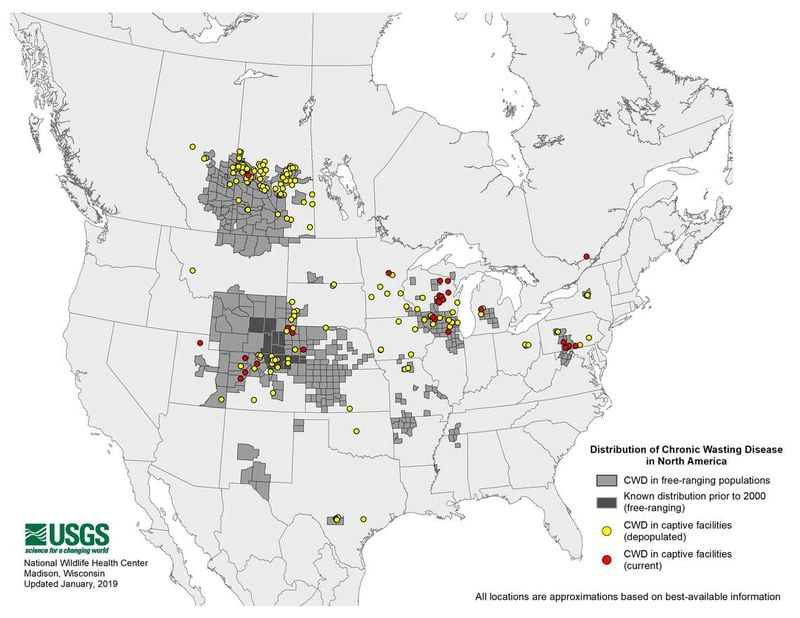This story has been updated. A previous version of this story cited Colorado State University's Prion Research Center as finding a primate link, but their research did not touch on macaque monkeys. We have included a separate study from prion researchers with the Canadian Food Inspection Agency to address this association. The new version also includes a rebuttal statement from the North American Deer Farmers Association.
Deer across North America are dying from a mysterious disease that gradually destroys the animal’s nervous system.
» RELATED: Killer herpes from Florida monkeys could pass to humans, scientists warn
And scientists are concerned that the infection could make its way to humans.
Chronic wasting disease — or “zombie deer disease” — was first observed in 1967 in Fort Collins, Colorado, and has since infected wild herds in 24 U.S. states and Canada, as well as in South Korea and Norway, according to the Atlanta-based Centers for Disease Control and Prevention.
As of January 2019, 251 counties in 24 states reported CWD in free-ranging deer and elk (or cervids).
The following states have reported the disease: Arkansas, Colorado, Illinois, Iowa, Kansas, Maryland, Michigan, Minnesota, Mississippi, Missouri, Montana, Nebraska, New Mexico, New York, North Dakota, Pennsylvania, South Dakota, Tennessee, Texas, Utah, Virginia, West Virginia, Wisconsin and Wyoming. A whopping 42 counties in Nebraska reported CWD as of Feb. 19.
"CWD passes from animal to animal through prions, misfolded proteins that cause other proteins to misfold around them," NPR previously reported. "Different prion diseases tend to only harm certain species, but can evolve to overcome those limitations."
In some herds, as many as half of the animals carry prions.
But direct contact isn't the only way prions are transmitted. According to the New York Times, sick animals and cadavers can spread prions through plants and soil, which could be coated with deformed proteins for years, perhaps even decades.
» RELATED: Here's why monkeys have been sexually interacting with deer, study says
An animal infected with the disease can live two years before signs of symptoms, such as a vacant stare, thick saliva, exposed ribs, or drooping heads, become visible.
There have been no reported human illnesses due to the disease, and scientists don’t have conclusive evidence that infected meat has ever harmed people, suggesting a “species barrier” between humans and deer.
Wildlife authorities in Colorado and Pennsylvania, however, are pushing for hunting regulations to fight the spread of the disease among their local deer populations, according to the Denver Post.
And one ongoing study is raising concerns about the possibility of CWD spreading to macaque monkeys.
"Out of five monkeys that were fed infected white-tailed-deer meat, three tested positive for chronic wasting disease, according to Canadian news outlet The Tyee. The outlet cited a long-term study led by Stefanie Czub, a prominent prion researcher with the Canadian Food Inspection Agency, in which 18 macaque monkeys were exposed to CWD in a variety of ways: "by injecting infected material into the brain; through contact with skin; by feeding them infected meat; and intravenously."
According to the AP, that's "the first time that the disease has been found to spread to primates through the consumption of infected meat," Live Science reported.
“The assumption was for the longest time that chronic wasting disease was not a threat to human health,” Czub told The Tyee. “But with the new data it seems we need to revisit this view to some degree.”
The ongoing research was funded by the Alberta Prion Research Institute at the University of Calgary and began in 2009.
In contrast, a long-term peer reviewed study by the National Institutes of Health and published in the Journal of Virology "found no clinical, pathological or biochemical evidence suggestion that CWD was transmitted to macaques," the North American Deer Farmers Association wrote in an emailed rebuttal statement to The Atlanta Journal-Constitution.
» RELATED: Cobb workers rescue a deer found inside a water treatment tank
Research led by Mark Zabel, associate director at Colorado State University's Prion Research Center, also found that the prions involved in the "zombie disease," which scientists have only known about for 50 years, are probably still evolving, "which leads us to believe it's only a matter of time before a prion emerges that can spread to humans," NPR reported.
Mad cow disease, for example, is a prion disease that rooted from scrapie, a deadly disease that afflicts sheep. Once the prions were passed to cows, the cows developed a prion disease of their own (mad cow disease). And when humans ate the beef from those sick cows, they developed prions in their own brains. As of 2016, according to the Food and Drug Administration, 231 people had died from the condition.
Zabel believes the only way to get rid of CWD prions is to set controlled fires. But, "there's a lot that we still don't know and don't understand about the disease," Zabel said in an interview with the New York Times.
According to Michael Miller, senior wildlife veterinarian for Colorado Parks and Wildlife, mule deer submission more than tripled toward the end of 2017, and CWD continues to be prevalent in Colorado.
Public health officials in the area have been monitoring for CWD and other human brain-wasting diseases, such as Creutzfeldt-Jakob Disease.
But over the past 21 years, rising rates of both diseases haven’t impacted human health.
Still, Matt Dunfee, head of the Chronic Wasting Disease Alliance in Colorado, told NPR, "if you are hunting in an area where CWD is found, have your animal tested. If it comes back positive, don't eat the meat."
Read the full study published in the "Microbiology and Molecular Biology Reviews" at mmbr.asm.org.







